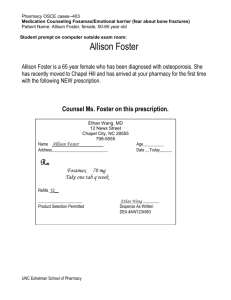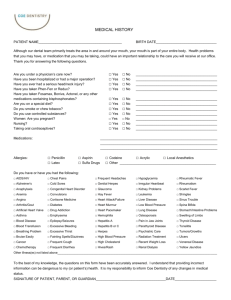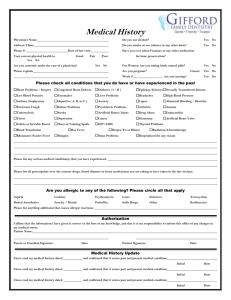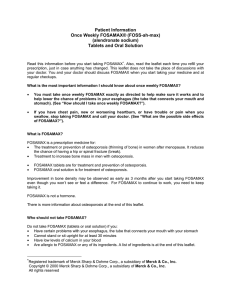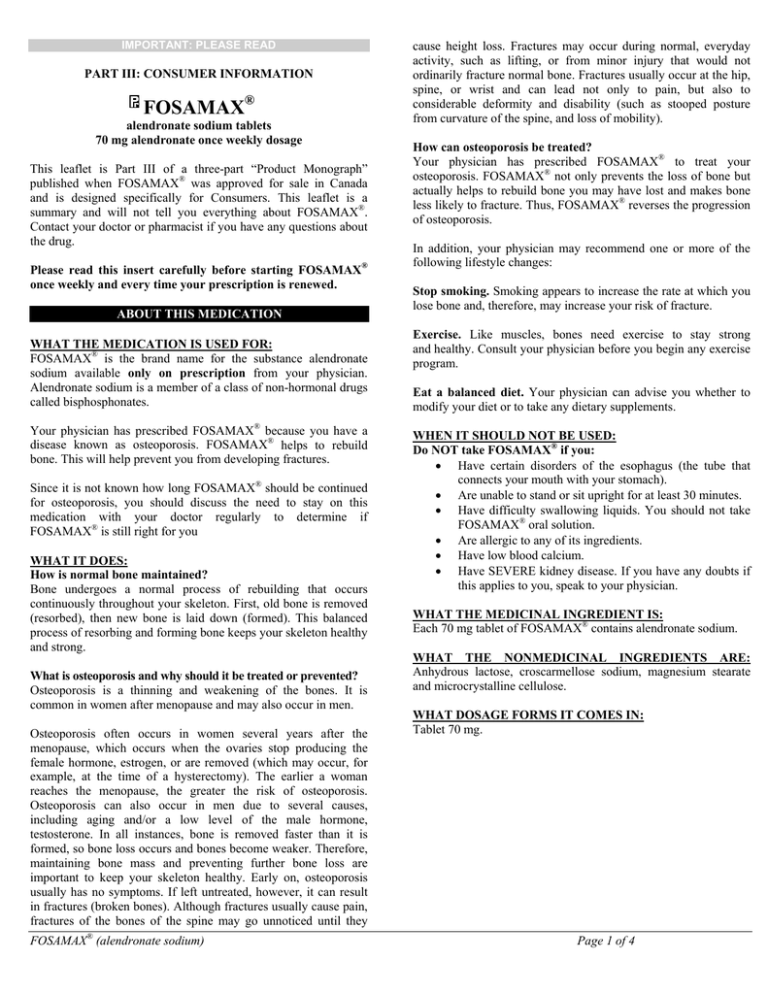
IMPORTANT: PLEASE READ cause height loss. Fractures may occur during normal, everyday
activity, such as lifting, or from minor injury that would not
ordinarily fracture normal bone. Fractures usually occur at the hip,
spine, or wrist and can lead not only to pain, but also to
considerable deformity and disability (such as stooped posture
from curvature of the spine, and loss of mobility).
PART III: CONSUMER INFORMATION
FOSAMAX®
alendronate sodium tablets
70 mg alendronate once weekly dosage
This leaflet is Part III of a three-part “Product Monograph”
published when FOSAMAX® was approved for sale in Canada
and is designed specifically for Consumers. This leaflet is a
summary and will not tell you everything about FOSAMAX®.
Contact your doctor or pharmacist if you have any questions about
the drug.
Please read this insert carefully before starting FOSAMAX
once weekly and every time your prescription is renewed.
®
ABOUT THIS MEDICATION
WHAT THE MEDICATION IS USED FOR:
FOSAMAX® is the brand name for the substance alendronate
sodium available only on prescription from your physician.
Alendronate sodium is a member of a class of non-hormonal drugs
called bisphosphonates.
Your physician has prescribed FOSAMAX® because you have a
disease known as osteoporosis. FOSAMAX® helps to rebuild
bone. This will help prevent you from developing fractures.
Since it is not known how long FOSAMAX® should be continued
for osteoporosis, you should discuss the need to stay on this
medication with your doctor regularly to determine if
FOSAMAX® is still right for you
WHAT IT DOES:
How is normal bone maintained?
Bone undergoes a normal process of rebuilding that occurs
continuously throughout your skeleton. First, old bone is removed
(resorbed), then new bone is laid down (formed). This balanced
process of resorbing and forming bone keeps your skeleton healthy
and strong.
What is osteoporosis and why should it be treated or prevented?
Osteoporosis is a thinning and weakening of the bones. It is
common in women after menopause and may also occur in men.
Osteoporosis often occurs in women several years after the
menopause, which occurs when the ovaries stop producing the
female hormone, estrogen, or are removed (which may occur, for
example, at the time of a hysterectomy). The earlier a woman
reaches the menopause, the greater the risk of osteoporosis.
Osteoporosis can also occur in men due to several causes,
including aging and/or a low level of the male hormone,
testosterone. In all instances, bone is removed faster than it is
formed, so bone loss occurs and bones become weaker. Therefore,
maintaining bone mass and preventing further bone loss are
important to keep your skeleton healthy. Early on, osteoporosis
usually has no symptoms. If left untreated, however, it can result
in fractures (broken bones). Although fractures usually cause pain,
fractures of the bones of the spine may go unnoticed until they
FOSAMAX® (alendronate sodium)
How can osteoporosis be treated?
Your physician has prescribed FOSAMAX® to treat your
osteoporosis. FOSAMAX® not only prevents the loss of bone but
actually helps to rebuild bone you may have lost and makes bone
less likely to fracture. Thus, FOSAMAX® reverses the progression
of osteoporosis.
In addition, your physician may recommend one or more of the
following lifestyle changes:
Stop smoking. Smoking appears to increase the rate at which you
lose bone and, therefore, may increase your risk of fracture.
Exercise. Like muscles, bones need exercise to stay strong
and healthy. Consult your physician before you begin any exercise
program.
Eat a balanced diet. Your physician can advise you whether to
modify your diet or to take any dietary supplements.
WHEN IT SHOULD NOT BE USED:
Do NOT take FOSAMAX® if you:
Have certain disorders of the esophagus (the tube that
connects your mouth with your stomach).
Are unable to stand or sit upright for at least 30 minutes.
Have difficulty swallowing liquids. You should not take
FOSAMAX® oral solution.
Are allergic to any of its ingredients.
Have low blood calcium.
Have SEVERE kidney disease. If you have any doubts if
this applies to you, speak to your physician.
WHAT THE MEDICINAL INGREDIENT IS:
Each 70 mg tablet of FOSAMAX® contains alendronate sodium.
WHAT THE NONMEDICINAL INGREDIENTS ARE:
Anhydrous lactose, croscarmellose sodium, magnesium stearate
and microcrystalline cellulose.
WHAT DOSAGE FORMS IT COMES IN:
Tablet 70 mg.
Page 1 of 4
WARNINGS AND PRECAUTIONS
BEFORE you use FOSAMAX® talk to your doctor or
pharmacist if you:
have cancer, gum disease, poor oral hygiene, or diabetes.
get chemotherapy, or radiotherapy.
take corticosteroids, or immunosuppressive drugs.
take angiogenesis inhibitors; they are drugs that slow
down the growth of new blood vessels and are used
mostly to treat cancer (e.g. bevacizumab).
are or have been a smoker.
are a heavy alcohol user.
If any of the above apply to you, have a dental check-up
before starting FOSAMAX®.
have or have had any medical problems including known
kidney disease.
have or have had any dental problems.
have any allergies.
have any swallowing or digestive problems.
You should always tell your physician about all drugs you are taking
or plan to take, including those obtained without a prescription.
Talk to your doctor:
if you have ear pain and/or discharge from the ear while
taking FOSAMAX® as these could be signs of bone
damage in the ear.
Use in pregnancy and breast-feeding
Do not take FOSAMAX® if you are pregnant or breast-feeding.
Use in children
FOSAMAX® is not indicated for use in children under 18 years of age.
Use in elderly
FOSAMAX® works equally well in, and is equally well tolerated
by, patients older and younger than 65 years of age.
Every week, take one tablet of FOSAMAX® on your chosen
day.
2. After getting up for the day and before taking your first
food, beverage, or other medication, take your FOSAMAX®
with plain water only as follows:
Swallow one tablet with a full glass (200 to 250 mL) of plain
water.
Do NOT take FOSAMAX® with:
- mineral water
- coffee or tea
- juice
Although it has not been tested, because of high mineral content,
“hard water” may decrease absorption of FOSAMAX®. If your
normal drinking water is classified as “hard water”, you should
consider taking this medication with distilled water (i.e., not
mineral water).
Do NOT chew or suck on a tablet of FOSAMAX®.
3. After taking your FOSAMAX®, do not lie down - stay fully
upright (sitting, standing or walking) for at least 30 minutes and
do not lie down until after your first food of the day.
4. Do NOT take FOSAMAX® at bedtime or before getting up
for the day.
The above actions will help FOSAMAX® reach your stomach
quickly and help reduce the potential for irritation of your
esophagus (the tube that connects your mouth with your stomach).
5. After taking your FOSAMAX®, wait at least 30 minutes
before taking your first food, beverage, or other medication of
the day, including antacids, calcium supplements and vitamins.
FOSAMAX® is effective only if taken when your stomach is
empty.
Driving and using machines: There have been side effects
reported with FOSAMAX® that may affect your ability to drive or
operate machinery. Individual responses to FOSAMAX® may
vary.
6. If you develop difficulty or pain upon swallowing, chest
pain, or new or worsening heartburn, stop taking FOSAMAX®
immediately and call your doctor.
INTERACTIONS WITH THIS MEDICATION
7. It is important that you continue taking FOSAMAX® for as
long as your doctor prescribes it. FOSAMAX® can treat your
osteoporosis only if you continue to take it.
Calcium supplements, antacids, and other oral medications will
interfere with the absorption of FOSAMAX® if they are taken at
the same time. You must wait at least one-half hour after taking
FOSAMAX® before taking any other oral medication.
Calcium and vitamin D are also important for strong bones. Your
doctor may ask you to take calcium and vitamin D while you are
on FOSAMAX® therapy.
PROPER USE OF THIS MEDICATION
USUAL DOSE:
Your doctor has prescribed FOSAMAX® once weekly tablets.
These are the important things you must do to help make sure you
will benefit from FOSAMAX®:
1.
Choose the day of the week that best fits your schedule.
FOSAMAX® (alendronate sodium)
It is important to take FOSAMAX® over the long-term to continue
to help rebuild bone you may have lost. It is, therefore, important
to follow your physician’s instructions for taking FOSAMAX®
without skipping doses or varying from your prescribed treatment
schedule. It is also important to continue to follow your
physician’s advice on lifestyle changes.
OVERDOSE:
If you take too many doses, drink a full glass of milk and contact your
Page 2 of 4
physician immediately. Do not induce vomiting. Do not lie down.
In case of drug overdose, contact a health care practitioner,
hospital emergency department or regional Poison Control Centre
immediately, even if there are no symptoms.
MISSED DOSE: If you miss a dose, just take one dose of
FOSAMAX® on the morning after you remember. Do NOT take
two doses on the same day. Return to taking one dose once a week,
as originally scheduled on your chosen day.
SERIOUS SIDE EFFECTS, HOW OFTEN THEY HAPPEN
AND WHAT TO DO ABOUT THEM
FOSAMAX® may have unintended or undesirable effects:
digestive problems such as nausea, vomiting, diarrhea or
constipation.
disorders of your esophagus (the tube that connects your
mouth with your stomach) including irritation which can
cause chest pain, heartburn or difficulty or pain upon
swallowing. These reactions may occur especially if
patients do not drink the recommended amount of water
with FOSAMAX® and/or if they lie down in less than 30
minutes or before their first food of the day. Esophageal
reactions may worsen if patients continue to take
FOSAMAX® after developing symptoms suggesting
irritation of the esophagus.
bone, muscle and/or joint pain.
joint swelling or swelling in their hands or legs.
transient flu-like symptoms (rarely with fever).
rash that may be made worse by sunlight, hair loss.
dizziness, vertigo (spinning sensation) or a changed sense
of taste.
symptoms of low blood calcium (for example, numbness
or tingling around the mouth or in the hands or feet;
muscle spasms in the face, hands, or feet).
SERIOUS SIDE EFFECTS, HOW OFTEN THEY HAPPEN AND
WHAT TO DO ABOUT THEM
Symptoms / effects
Talk with your
doctor or
pharmacist
Only if
severe
In all
cases
Stop taking
drug and
call your
doctor or
pharmacist
Uncommon
Allergic reactions such as:
- hives
- swelling of the face, lips,
tongue and/or throat
- difficulty in breathing or
swallowing
√
Severe bone, joint, and/or
muscle pain
New or unusual pain in the hip
or thigh
Esophageal ulcers causing:
- chest pain
- heartburn
- difficulty or pain upon
swallowing
√
√
√
Stomach or other peptic ulcers
occasionally associated with
black and/or bloody stools
√
Jaw problems associated with
delayed healing and infection,
often following tooth extraction
√
Eye inflammation associated
with eye pain; eye redness;
sensitivity to light, decreased
vision
√
Severe skin reactions
√
Symptoms of low blood calcium:
- numbness or tingling around
the mouth or in the hands or
feet
- muscle spasms in the face,
hands, or feet
√
Rare
mouth ulcers have occurred when the tablet was chewed
or dissolved in the mouth.
Persistent ear pain
√
This is not a complete list of side effects. For any unexpected
effects while taking FOSAMAX®, contact your doctor or
pharmacist.
If any of these affects you severely, tell your doctor or
pharmacist.
FOSAMAX® (alendronate sodium)
Page 3 of 4
This leaflet was prepared by Merck Canada Inc.
REPORTING SUSPECTED SIDE EFFECTS
You can help improve the safe use of health products for
Canadians by reporting serious and unexpected side effects to
Health Canada. Your report may help to identify new side effects
and change the product safety information.
Last revised: December 23, 2015
®
Merck Sharp & Dohme Corp. Used under license.
© 2011, 2015 Merck Canada Inc. All rights reserved.
3 ways to report:
Online at MedEffect (http://hc-sc.gc.ca/dhpmps/medeff/index-eng.php);
By calling 1-866-234-2345 (toll-free);
By completing a Consumer Side Effect Reporting Form
and sending it by:
- Fax to 1-866-678-6789 (toll-free), or
- Mail to: Canada Vigilance Program
Health Canada
Postal Locator 0701E
Ottawa, Ontario
K1A 0K9
Postage paid labels and the Consumer Side Effect Reporting
Form are available at MedEffect (http://hc-sc.gc.ca/dhpmps/medeff/index-eng.php).
NOTE: Contact your health professional if you need information
about how to manage your side effects. The Canada Vigilance
Program does not provide medical advice.
HOW TO STORE IT
Store at room temperature (15°C–30°C).
Do not use this medicine after the month and year written after
EXP (expiry date) on the container.
Remember to keep FOSAMAX® and all medications safely
away from children.
MORE INFORMATION
NOTE: This INFORMATION FOR THE CONSUMER leaflet
provides you with the most current information at the time of
printing.
The most current information, the Consumer Information Leaflet
plus the full Product Monograph, prepared for health professionals
can be found at: http://www.merck.ca or by contacting the
sponsor, Merck Canada Inc.:
By toll-free telephone: 1-800-567-2594
By toll-free fax: 1-877-428-8675
By regular mail:
Merck Canada Inc.
Medical Information Center
16750 route Transcanadienne
Kirkland QC H9H 4M7
FOSAMAX® (alendronate sodium)
Page 4 of 4

